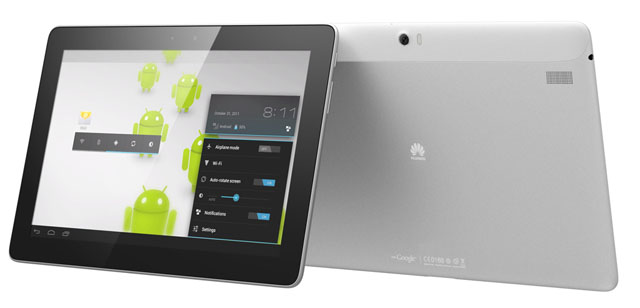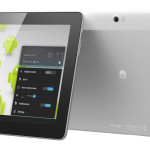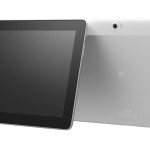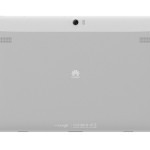review Like its smartphone cousin, the Ascend P2, Huawei’s 10″ MediaPad is an Android device with a very specific claim: That it offers the fastest mobile broadband possible. But does its support for ‘Cat4’ 4G speeds do enough to differentiate the MediaPad from the crowd? Read on to find out.
Design
When evaluating most Android tablets, sometimes we wonder what these devices would have looked like if Apple had never come up with its iconic iPad. The reason is that so many Android tablets look so much like one of Apple’s larger iPad, that it’s clear their design has been ‘inspired’, to say the least, by Apple’s own.
In this vein, the MediaPad is no standout. You get the same large, 10″ touchscreen found on most other tablets, surrounded by the same large black border. You get the same silvery, metallic/plasticky back, with the camera positioned in the same spot and the same rounded edges and lip, so that the MediaPad can be scooped up from a desk. The main difference which is obvious with the MediaPad is that there’s a large white ‘cap’ on the device’s back, including two decent-sized speakers.
All the normal ports and physical buttons are included. The on/off button and volume rocker are on the unit’s right-hand side at the top, if you hold it horizontally. There are front-facing and back-facing cameras, a microUSB port, a 3.5mm headphone socket and so on. At 257.4mm by 175.9mm, and at 9.9mm thick, the MediaPad couldn’t feel more standard for an Android tablet. We’ve seen this form factor dozens of times before. There’s really not much here you wouldn’t expect, and pretty much everything you would expect.
In general, however, we liked the touch and feel of the MediaPad. It feels comfortable in the hand, and it has a level of build quality which Huawei has been gradually building up to recently with its recent releases. The MediaPad may be designed pretty much like most other Android tablets, but it feels good, even so — this design is not fundamentally broken. Just don’t expect it to stand out from the crowd at all.
Features
The hero feature of the MediaPad is, like the Ascend P2 smartphone we reviewed yesterday, its support for what is called ‘category 4′ or ‘CAT4′ speeds across the mobile broadband networks operated by Telstra, Optus and Vodafone. This means that in areas where the carriers use 20Mhz of contiguous spectrum, the MediaPad should be able to achieve moderately faster speeds than would be possible otherwise. I expect to shortly see most other smartphone manufacturers and many tablet also gradually adopt the CAT4 4G/LTE standard in their devices — it’s only a matter of time.
Vodafone, which is exclusively supporting the MediaPad for launch in Australia, is certainly quite excited to be launching the high-speed device locally, billing the MediaPad as being capable of speeds up to 150Mbps in some areas.
Apart from this hero feature, most of the other specifications of the MediaPad are a little humdrum. It runs a slightly outdated version 4.1 of Android, its 10.1 IPS screen runs at a resolution of 1280×800, delivering a fairly poor pixel density rating, by today’s standards, of 149PPI, and its back-facing camera is only rated at three megapixels. Its front camera is a “VGA” model.
The unit’s processor, however, is quite powerful, being rated at 1.5GHz and with four cores, and its battery size is substantial, at 6400mAh. The unit comes with 16GB of on-board storage and can take a microSD card for an additional storage expansion of up to 32GB.
Performance
OK, let’s start with the best part of the MediaPad’s performance. Firstly, let me say up-front that, as with the Ascend P2, its mobile broadband speeds are definitely impressive. Provided you’re in the right coverage area, you’ll be able to achieve mobile broadband access at speeds of up to 112Mbps, in our testing, with speeds of 90Mbps quite normal. We saw upload speeds in those areas of around 23Mbps, consistently. These speeds are pretty phenomenal, and translated into a real-life situation where basically anything you could load on the MediaPad (including HD YouTube videos, for example, would arrive instantly).
Likewise, we found the battery performance of the MediaPad to be very solid. Even when you’re streaming hours of high-definition content (our personal favourite is to jump on YouTube and watch videos of Dark Souls PvP action), you’re not going to see much hit to the MediaPad’s battery, and it’s also the kind of unit, like many tablets we’ve tested, which you can leave on your desk for a week or so, and expect to come back and just pick it up and start using it without a problem.
Software performance was pretty good, in that apps loaded and ran fine on the MediaPad, and there was less of the slightly jerky user interface behaviour we’ve seen on some of Huawei’s other devices. Although this isn’t stock Android, and we would prefer to see Huawei implement something similar to Google’s ‘Nexus experience’ here, with a more modern version of Android, the user interface of the MediaPad is inoffensive and works. It’s not too far away from the default (read: ‘Best’) Android experience.
Likewise, the sound and video quality of the MediaPad is also quite good. It’s enjoyable watching video and listening to audio on the device; its screen quality and speaker quality are both more than acceptable, even if they’re not remarkable in any way. Of course, at only three megapixels, the MediaPad’s camera was always going to be a bit of a letdown. It’ll do for happy snaps or video of the kids playing around the house, but don’t expect the quality to be anything to write home about. This camera truly is not on par with smartphone and tablet cameras on modern devices launching in mid-2013 in Australia.
Right now, Huawei’s MediaPad is available exclusively through Vodafone, included on either one of three ‘tablet’ plans, for $35, $45 or $60 per month, with 2.5GB, 4GB or 8GB of data quota per month.
Conclusion
Let’s make no bones about it: Huawei’s MediaPad 10 Link 4G is a very good Android tablet. It has all the features you’d want from a tablet in its class, it features solid build quality, and it comes with superior mobile broadband speeds which will knock your socks off. It’s a decent device, and is clearly designed for Huawei to be able to partner with telcos such as Vodafone on giving customers another option for mobile broadband access.
However, there is one big problem with the device: Apart from its mobile broadband speeds, which are pretty much unmatched by its competitors, nothing really stands out about this very standardised Android tablet’s performance in terms of giving it an edge on its competition.
With a mediocre camera, screen and speakers of acceptable but not remarkable quality, acceptable build quality, standardised dimensions, a user interface that is decent but not outstanding, and so on, there really isn’t much that helps the MediaPad stand out from the pack. Right now, it’s the only tablet device with CAT4 support in Australia, but this advantage won’t last for long — it’s a virtual certainty that the standard will be making its way into competing devices very shortly, and then what will be the point of buying a MediaPad? Not much, to our mind. Not much.
It’s possible to argue that the price of the MediaPad gives it an edge on the competition. However, when you look closer at Vodafone’s plans for the device, what you’ll find is that a monthly charge for the MediaPad is already factored in. For example, Vodafone’s $35 plan is actually broken up into $15 per month for the MediaPad, and $20 for the network access. Over a 24 month plan, this means you’ll actually be paying $360 for the MediaPad, which is not too far from competing prices for competing tablets. The iPad mini, for example, starts at $369 (without 4G access) and Apple’s iPad itself starts at $539. Google’s Nexus 10 (again, without 4G access) starts at $469 in Australia. All of these models are superior to the MediaPad, and you might wonder whether you really need mobile broadband access via your tablet, when you can just tether your smartphone.
In this context, the MediaPad comes across as a bit of a mixed beast. It doesn’t compete with the top-end of town when it comes to being a tablet, and we’d argue that it’s only at the top-end of town that Android tablet buyers should really be looking at, at the moment, as the lower to medium end of the Android tablet market is quite mediocre.
Perhaps the best way to sum up the MediaPad is to say that it reminds your writer strongly of the first smartphones launched in Australia that supported 4G speeds. The main feature these units had to offer was 4G access — but their other features and design were relatively standardised and didn’t offer any advantages over their 3G competition. I suspect that in six months, when a lot more devices have been launched in Australia with CAT4 4G support, the MediaPad will look like an also-ran. It’s a solid tablet, but in this cut-throat market, devices need to be more than solid to be worthy of a purchase.
Image credit: Huawei





